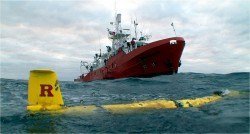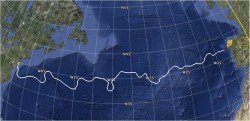Deep-sea Glider

The first robot to cross the Atlantic offers new possibilities for ocean and climate research
(From The Washington Post / by David Brown) — She was at sea for 221 days. She was alone, often in dangerous places, and usually out of touch. Her predecessor had disappeared on a similar trip, probably killed by a shark. Yet she was always able to do what was asked, to head in a different direction on a moment’s notice and report back without complaint.So is it any surprise tears were shed when people could finally wrap their arms around her steel torso once more?
“She was a hero,” said Rutgers University oceanographer Scott Glenn last week after retrieving an aquatic glider called the Scarlet Knight from the stormy Atlantic off western Spain. The 7-foot-9-inch submersible device, shaped like a large-winged torpedo, had just become the first robot to cross an ocean.
Named after the New Jersey university’s athletic teams and officially designated RU-27 in a long line of related devices, this one was always known simply as “Scarlet.” Like Charles Lindbergh’s Spirit of St. Louis, or perhaps Columbus’s Pinta and Niña, it seemed more a living thing than a mechanical conveyance. But unlike them, Scarlet crossed the Atlantic without a single passenger.
The people responsible for building, funding and flyingScarlet hope the end of the robot’s successful voyage will mark a new start in ocean and climate research.
“We think this will just be a precursor, like Lindbergh’s trip across the Atlantic,” said Clayton Jones, an engineer at Teledyne Webb Research, in Falmouth, Mass., which made Scarlet. “In a decade we think it will be commonplace to have roving fleets of these gliders making transoceanic trips around the world.”
“This really is a seminal event for us,” said Richard W. Spinrad, assistant administrator for research in the National Oceanic and Atmospheric Administration. “We see gliders as offering a whole new world in our capability of using the oceans to help answer society’s questions.”
“We’re ready to do it again,” Glenn said from Spain last week, where he, a half-dozen members of the Rutgers team, and a U.S. government official went to pick up the glider from Spanish colleagues. “If we can do it once, we can do it 10 times, and if we can do it 10 times, we can do it 100 times.”
More data
Gathering more data from the oceans, which cover 71 percent of the Earth’s surface, is essential to understanding global climate change. The temperature, salinity and acidity of ocean water are all affected by atmospheric warming and the accumulation of greenhouse gases. The warm surface layer is the engine that drives hurricanes. Changes in currents can portend changes in weather; understanding currents better can be of great practical use to fishing and oceangoing commerce.
“In general, access to the ocean is the limiting factor to those who do ocean science,” said Jerry L. Miller, a senior policy analyst at the White House Office of Science and Technology Policy, who accompanied the research team to Spain. “When we have hundreds of them, or thousands of them, it will revolutionize how we can observe the oceans.”
Currently, oceanographic data are gathered in three ways. Satellites collect information on water temperature, color, currents and other surface features. Subsurface water is sampled by the so-called Argo system of 3,000 untethered buoys that wander the oceans, periodically sinking to depths of up to 6,500 feet to take measurements before rising again to the surface and transmitting the information to shore stations. The third way is with manned research vessels, which can cost up to $30,000 a day to operate. At a price of $100,000 to $150,000 apiece (which is likely to drop once large-scale production begins), fleets of aquatic gliders outfitted with varying arrays of physical, chemical, acoustical and optical sensors promise to increase the store of data considerably at reasonable cost. The U.S. Navy has just ordered 150.
Scarlet’s recovery on Dec. 4 ended a trip that began April 27 off the coast of New Jersey. For those seven months she was directed by computer, modem, satellite and GPS device from a control room on the Rutgers campus and, one time, from Palmer Research Station in Antarctica. Most of the time, however, the glider was out of contact underwater, moving slowly up and down to depths of 600 feet, safe from ships, nets and storms.
Along the way, Scarlet took measurements of temperature and salinity of the water. From its position at each surfacing, the researchers could calculate the net effect of currents deep and shallow. After surface currents were measured, the scientists could then make inferences about what was happening deeper in the water column. The data were uploaded to researchers three times a day, when the glider surfaced and called home via an Iridium telephone parked in its tail.
“This robot’s life depended on everybody’s cooperation, and that motivated people in a way you don’t usually see,” Glenn said. “It took on this living presence. Everybody wanted to save this robot. She was a force that united scientists from many nations.”
The gliders that follow her are likely to be nameless and thankless drones that wander the seas on automatic pilot, uploading data to other machines. They will have all the personality and sex appeal of weather balloons.
Which is actually the point.
“What we want is to have all sorts of cheap sensors, all tweeting back information to give us that full voice of the sea. Omnipresence — that’s our concept,” Glenn said.
Flying through the water

The analogy to weather balloons — and to atmospheric activities in general — is apt.
Scarlet is more similar to an airborne glider than a submarine. Like the former, it has no engine to provide forward thrust or motion. It descends by pumping a small volume of water — about a cup — into its nose, causing that part of the glider to sink relative to the tail. Because of the unequal buoyancy along the fuselage and the action of its two stationary wings, the glider makes headway as it “flies” downward in the water column. To ascend, the reverse occurs: it pumps the water out of the nose, which then floats upward, pulling the rest of the glider with it.
The glider cannot travel forward at a fixed depth. Consequently, its course across the Atlantic took the form of a series of more than 10,000 dives and ascents, usually staying well below the surface.
For many ocean creatures, the surface is where danger lies, and that was the case with Scarlet as well.
The hazards were apparent early in the trip, when the glider crossed the shipping lanes off the East Coast and passed through the heavily fished offshore canyons and continental shelf. Over the past decade, Glenn and his fellow lead scientist, Oscar Schofield, have created an ocean observatory off the New Jersey coast, collecting current and temperature data of value to commercial fishermen and making it available for free. The fishermen, in turn, provided information about the location of ships and nets during the first treacherous week.
“Nets scare me,” Schofield said last week. “Just as they are designed to catch fish, they will catch gliders.” Scarlet stayed underwater for eight hours at a stretch, diving deep under nets and, with the peak of its ascents at 60 feet, keeping well below the draft of the biggest oceangoing vessels. A few times a day it would surface for a few minutes to get a new waypoint toward which to head.
“When we are in a danger zone, we really minimize our time at the surface and try to get back underwater,” Schofield said.
As a rule, though, there isn’t much that bothers a glider. In November, the Rutgers team had a pack of four gliders off the Jersey shore, practicing what Schofield called “swarming behaviors.” While they were out, a nor’easter came along the coast. The gliders stayed safely underwater, taking measurements of how the storm was reshaping the sea floor.
Going with the flow
For much of the recent trip, Scarlet rode the Gulf Stream, a powerful current that flows north and east off the coast of North America before crossing the Atlantic and dividing into several smaller currents off the west coast of Europe.
But things got tricky when it began to approach Spain. The glider began to struggle against westbound currents. One option was to use Scarlet’s rudder to head south, toward Portugal. The other was to go north, around the top of a large eddy, and then turn again east.
At the suggestion of one of their Spanish collaborators, Antonio Gonzalez, the Rutgers team opted for the northern route. After all, it had worked before.
In February 1493, Columbus’s two-ship fleet returning from the New World faced a similar predicament. (The admiral’s flagship, the Santa Maria, had wrecked off Haiti on Christmas Day 1492.) The Pinta and Niña had survived a big storm, but the Pinta was heavily damaged and had trouble making headway in the same currents Scarlet encountered. Her captain, Martín Alonso Pinzón , sailed north into calmer waters, while Columbus, on the Niña, sailed south. Pinzón eventually caught favorable southeast winds and landed in Baiona, Spain — which, as it happens, is where the Spaniards turned Scarlet over to the Americans on Dec. 9.
“We had the spirit of Pinzón looking out for us in the final leg,” Schofield said.
Scarlet’s struggle, however, was nothing compared with what befell the RU-17, a similar glider the Rutgers team attempted to get across the Atlantic last year. It collided with something underwater while it was off the Azores, triggering an emergency surfacing maneuver. It was leaking too much to save itself, however, and was lost.
“Something violent and strong hit it from below. There’s not that much out there. If you’re a betting man, shark is probably the answer,” Schofield said.
The scientists who partnered for this project have received critical support from the National Oceanographic Partnership Program (NOPP) to conduct pioneering research on the ocean environment. As a result, their work has advanced the nation’s ocean observing capabilities.


